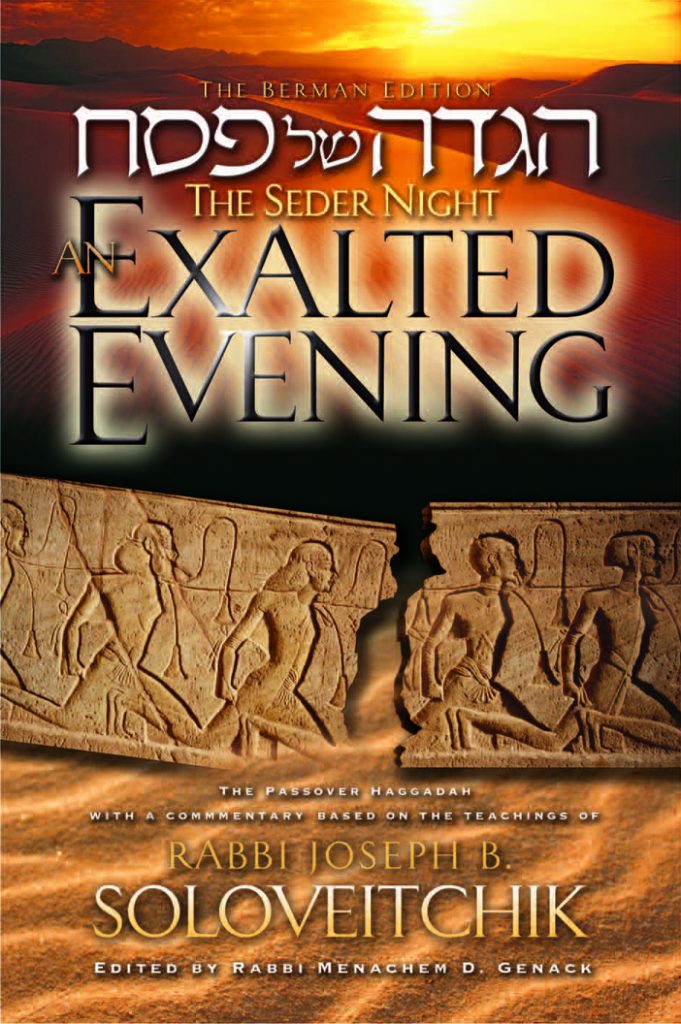Based on a commentary in the new Haggadah, The Seder Night: An Exalted Evening, with the commentary of “the Rav”, Rabbi Joseph Soloveitchik . Compiled by Rabbi Simon Posner.
 Just as a multi-faceted jewel reveals its beauty in a myriad of reflections, so too the Seder expresses a rich array of meaning. For the Rav, one of the most important aspects of the Seder is its role as a medium for teaching Torah. The Seder is celebrated by a community within which one shares not only his material goods, but also his spiritual treasures, his knowledge, experiences, aspirations and hopes. The Seder community is a teaching community. The form which the halachah has prescribed for the narration of the events of the Exodus is more a study than a tale, more a discourse about mitzvoth than a narrative. Had Chazal simply wanted the story to be told, the events to be recounted in detail, they would have introduced as mandatory the recital of the sections of Sefer Shmot dealing with the saga of slavery and freedom.
Just as a multi-faceted jewel reveals its beauty in a myriad of reflections, so too the Seder expresses a rich array of meaning. For the Rav, one of the most important aspects of the Seder is its role as a medium for teaching Torah. The Seder is celebrated by a community within which one shares not only his material goods, but also his spiritual treasures, his knowledge, experiences, aspirations and hopes. The Seder community is a teaching community. The form which the halachah has prescribed for the narration of the events of the Exodus is more a study than a tale, more a discourse about mitzvoth than a narrative. Had Chazal simply wanted the story to be told, the events to be recounted in detail, they would have introduced as mandatory the recital of the sections of Sefer Shmot dealing with the saga of slavery and freedom.
Every Jewish home on the Seder night becomes a teaching community, a school where a class of disciples is instructed in Judaism. The teacher tells the wondrous story of slaves who in one night turned into princes, into a kingdom of priests. Passover night is the night of masorah, of handing down, transmitting the knowledge, the ancient tradition, our world outlook, aspirations, and visions to all kinds of children—bright and dull, obedient and rebellious, engaged and indifferent. The meal thus is turned into a “symposium,” into a rendezvous with Torah.
The Haggadah’s story of the rabbis in Bnei Brak who spent the entire night telling the story of the Exodus is for the Rav symbolic of the Torah teaching that preserved the continuity of the Jewish people. The tale of the rabbis in Bnei Brak was not just an isolated historical event, but rather a perennial drama that has been enacted since antiquity thousands of times. The people who acted out this drama with tears and blood were not five or ten scholars, but countless individuals in each generation, anonymous fathers, unknown mothers, forgotten teachers, lonely souls, and tragic people. All of them were involved in one task, dedicated to one goal: “They were talking of Yetzi’at Mitzrayim all night.”
This is the central story of our destiny. We have survived; we are now building the Land of Israel. The key to the riddle of how we survived, the solution to this enigma of how we are able to read the Haggadah for thousands of years, lies with the teachers and parents who told the story of the Exodus throughout the whole night, throughout their lifespan. We mention here only one day, one generation, but it continued generation after generation. We are continuing it now, too. While waiting impatiently for daybreak, we shall continue to narrate the story of the Exodus, the tale of all tales, the sipur which never becomes obsolete, which is always powerful and fascinating.



